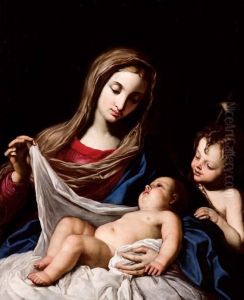Angelo Massarotti Paintings
Angelo Massarotti was an Italian painter and sculptor born in 1653 in Cremona, a city in the Lombardy region known for its rich artistic heritage. He lived during the Baroque period, a time characterized by dramatic use of light and color, elaborate decoration, and expressive intensity in art. Massarotti's works are notable for embodying these qualities, reflecting the dynamism and grandeur of the Baroque style.
Massarotti trained under the guidance of prominent artists of his time, which helped him develop a distinctive style that combined the grandiosity of Baroque art with elements of realism and emotional depth. Throughout his career, he worked on a variety of projects, including religious commissions for churches, which were common for artists of his era. His paintings often featured biblical and mythological themes, executed with a mastery over the interplay of light and shadow, a hallmark of Baroque painting.
In addition to painting, Massarotti was accomplished in sculpture, showcasing versatility uncommon among his contemporaries. His sculptures, like his paintings, were marked by an attention to detail and a lifelike quality that brought his subjects to vivid life. Despite his talent and contributions to the Baroque movement, Massarotti did not achieve the same level of fame as some of his contemporaries. Nevertheless, his work remains appreciated by art historians and collectors for its beauty and technical skill.
Angelo Massarotti's legacy is preserved in various Italian churches and collections, where his paintings and sculptures continue to be admired for their craftsmanship and emotional power. He passed away in 1723, leaving behind a body of work that, though not as widely recognized as that of some of his peers, contributes significantly to the richness of Baroque art. His contributions to the art world reflect the era's broader cultural movements, embodying the Baroque's intricate aesthetics and its emphasis on emotional expressiveness and dramatic intensity.



